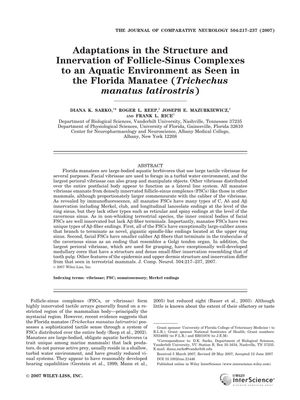TLDR Manatee whiskers are specially adapted for touch in water.
The study examined the structure and innervation of follicle-sinus complexes (FSCs) in the Florida manatee, revealing adaptations for their aquatic environment. Manatee FSCs, which are larger in proportion to their vibrissae, have a variety of innervation types, including C, Adelta, and Abeta fibers with Merkel, club, and longitudinal lanceolate endings, but lack reticular and spiny endings. Unique to manatees are two types of Abeta-fiber endings: large-caliber axons with spindle-like endings and smaller caliber fibers resembling Golgi tendon organs. The largest perioral vibrissae, used for grasping, have a well-developed medullary core with dense small-fiber innervation similar to tooth pulp. These findings suggest that manatee vibrissae are highly specialized for tactile sensation in an aquatic environment.
101 citations
,
August 2003 in “Journal of comparative neurology” Naked mole-rats have unique skin and hair nerve structures, lacking certain pain and temperature-related neuropeptides.
46 citations
,
August 1977 in “Journal of Morphology” The big-clawed shrew's sinus hair follicles are highly specialized for sensing vibrations.
 January 2022 in “Journal of St. Marianna University”
January 2022 in “Journal of St. Marianna University” Substances from human hair cells can affect hair loss-related genes, potentially leading to new treatments for baldness.
 15 citations
,
April 2014 in “Experimental Dermatology”
15 citations
,
April 2014 in “Experimental Dermatology” Scientists developed a system to study human hair growth using skin cells, which could help understand hair development and improve skin substitutes for medical use.
 321 citations
,
December 2009 in “Journal of Dermatological Science”
321 citations
,
December 2009 in “Journal of Dermatological Science” Dermal cells are key in controlling hair growth and could potentially be used in hair loss treatments, but more research is needed to improve hair regeneration methods.
32 citations
,
August 2006 in “Archives of Dermatological Research” Dermal papilla cells can help regrow hair follicles.
January 2003 in “Chinese Journal of Reparative and Reconstructive Surgery” Dermal papilla cells can help form hair follicles and produce hair.
 66 citations
,
August 2001 in “Experimental Dermatology”
66 citations
,
August 2001 in “Experimental Dermatology” Human hair follicle cells can grow hair when put into mouse skin if they stay in contact with mouse cells.
 57 citations
,
November 1998 in “Wound Repair and Regeneration”
57 citations
,
November 1998 in “Wound Repair and Regeneration” Hair papilla cells can create and regenerate hair bulbs under the right conditions.





